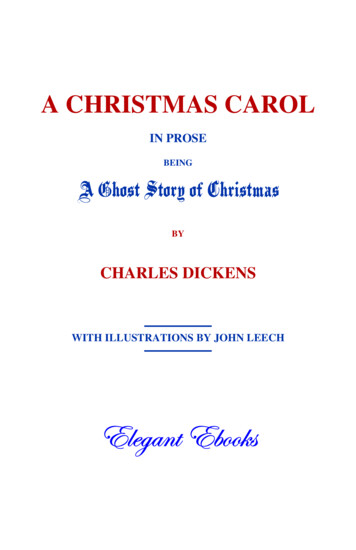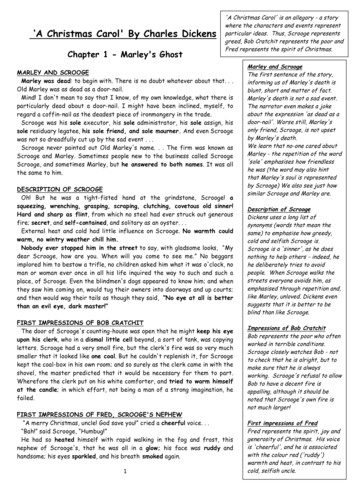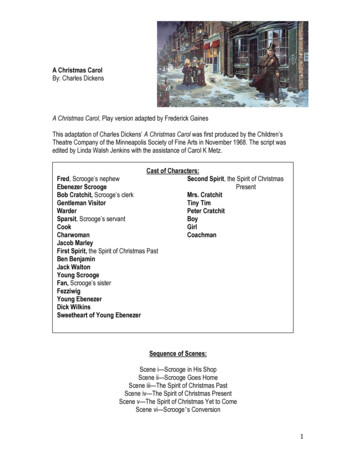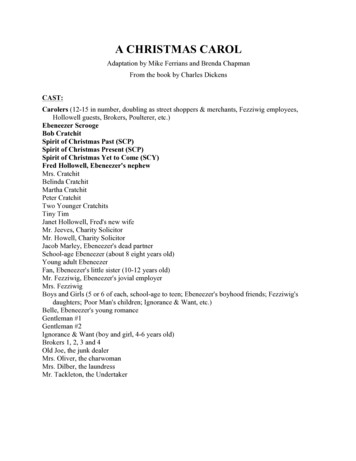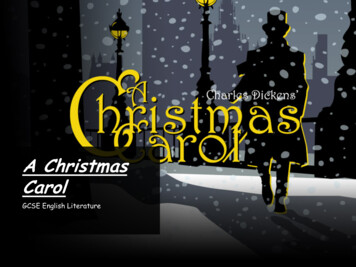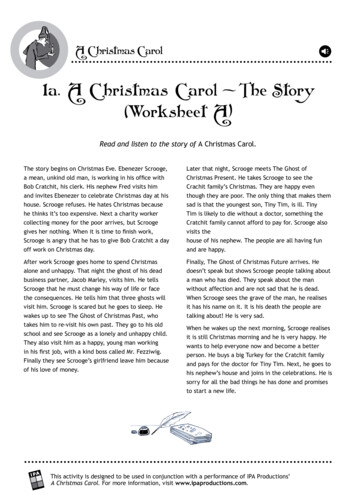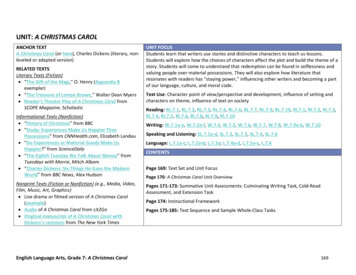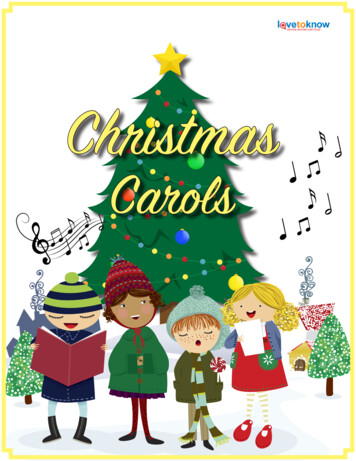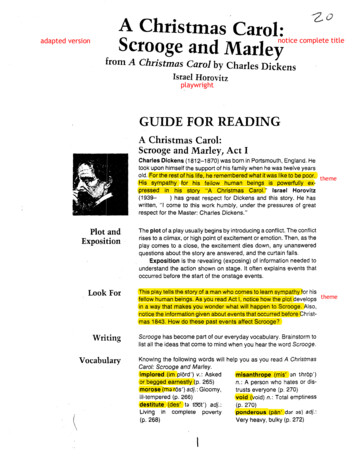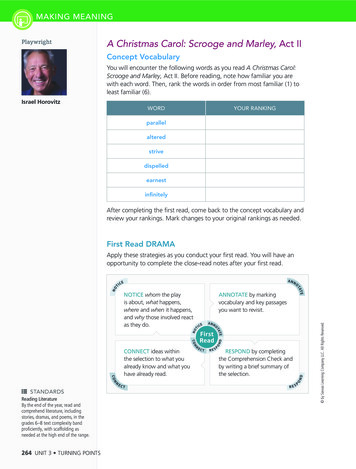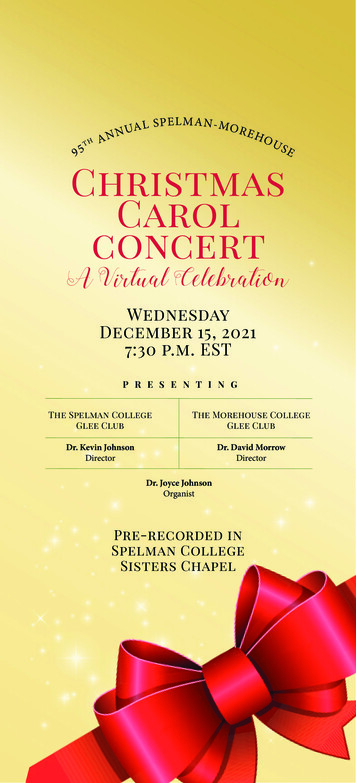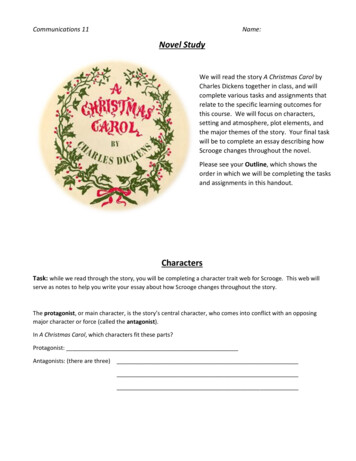
Transcription
Communications 11Name:Novel StudyWe will read the story A Christmas Carol byCharles Dickens together in class, and willcomplete various tasks and assignments thatrelate to the specific learning outcomes forthis course. We will focus on characters,setting and atmosphere, plot elements, andthe major themes of the story. Your final taskwill be to complete an essay describing howScrooge changes throughout the novel.Please see your Outline, which shows theorder in which we will be completing the tasksand assignments in this handout.CharactersTask: while we read through the story, you will be completing a character trait web for Scrooge. This web willserve as notes to help you write your essay about how Scrooge changes throughout the story.The protagonist, or main character, is the story’s central character, who comes into conflict with an opposingmajor character or force (called the antagonist).In A Christmas Carol, which characters fit these parts?Protagonist:Antagonists: (there are three)
Character typesRound A majorcharacter Very welldeveloped,seem like realpeople Has a complexpersonalityDynamicFlatStatic A character whoencountersconflict and ischanged by it Usually a majorcharacter A character whohas one kind ofpersonality trait A character whodoes not changeover timeTASK: Use the terms above to describe the following characters (some may fit more than one):CharacterCharacter type (above)Adjectives used to describe them(add to your web instead of here)ScroogeFred(Scrooge’s nephew)Fan(Scrooge’s younger sister)Fezziwig
Symbolism:Each of the ghosts that visit Scrooge represents certain ideas. What do each of the three ghostsrepresent? (Think of what they show him, or try to teach him). The Ghost of Christmas Past represents , because The Ghost of Christmas Present represents , because The Ghost of Christmas Yet to Come represents , becauseSetting & Atmosphere1. Where, and in what time period (year) does this story take place?The mood of a story evokes certain feelings in the reader through the words and descriptions that isuses. Usually, mood is referred to as the atmosphere of the story, as it creates an emotional situationthat surrounds the readers. The mood can be developed through the setting, tone, and word choice.2. What kind of mood or atmosphere is established in the beginning of A Christmas Carol? (Usesome words or quotes directly from the story.)
3. How does the mood/atmosphere at the beginning of the story relate to Scrooge’s charactertraits/personality?4. How do the mood and atmosphere change at the end of the story? Do these parallel any changesin Scrooge?Literary DevicesDickens uses many literary devices to enhance our understanding of the story. Find examples of literary devicesfrom the story to complete the chart below.Simile (comparing two things using “like” or “as”)oExample #1 (page #, quotation, and what it means)oExample #2 (page #, quotation, and what it means)
Personification (giving human traits to an object)oExample #1 (page #, quotation)oExample #2 (page #, quotation)Imagery (descriptive language that helps us to picture it in our mind)oExample #1 (page #, quotation)oExample #2 (page #, quotation)Onomatopoeia (words that sound similar to the sound they represent e.g. boom)oExample #1 (page #, quotation)oExample #2 (page #, quotation)
PlotExposition/Introduction: beginning ofstory, where characters, setting, and mainproblem are introduced.Rising Action: a series of events build upto the conflict. Excitement, tension, orcrisis is encountered.Climax: the turning point of the story. Amoment of interest and emotion, wherethe reader wonders what will happennext.Falling Action: events and complicationsstart to be resolved.Resolution/Conclusion: end of the story.Plot Assignment:Option A:Use a blank plot diagram, and label it with descriptions of the plot elements. For each plot element, write a fewsentences describing which part of the story fits there.Option B:Use the handout provided to create a storyboard/comic strip that illustrates which parts of the story fit with eachplot element.
Comprehension QuestionsStave One: Marley’s Ghost1. Compare Scrooge’s personality and views about Christmas with those of his nephew, Fred.ScroogeFredPersonality traits:Personality Traits:Views of Christmas:Views of Christmas:2. What are Scrooge’s views of the poor? Where does he think they belong? (pg.4)3. What message does Marley bring to Scrooge? (pg.10)Stave Two: The First of the Three Spirits1. Why does Scrooge’s girlfriend, Belle, break up with him? (pg.18-19)2. What are some regrets (things he would have liked to do) that Scrooge shares with us on pg.19?
Stave Three: The Second of the Three Spirits1. How is the Cratchit family described? (pg.27) Which part of society do they represent?2. How is the holiday of Christmas portrayed in this section? Do you think this is similar to howChristmas is celebrated here today?Stave Four: The Last of the Spirits1. How do the men that knew Scrooge react to his death? (pg.34)2. Upon seeing his grave, what does Scrooge vow to do? (pg.41)Stave Five: The End of It1. What are some of Scrooge’s actions that show he is now a changed man?
ThemesThe theme of a story is its underlying message or “big idea” that the author is trying to convey.Assignment: Choose ONE of the themes below, and write a paragraph (on a separate piece of paper)describing some things from the story that show that theme.A) The meaning of Christmas and of life: what is really important?B) Actions & Consequences: the lasting consequences that result from our actions (think of Marley’sactions and consequences, as well as Scrooge’s).C) The Power of One: the power that one person has to change their community or the world (thinkof how certain characters impact those around them- good or bad)D) Rebirth: it is never too late to change (think of the changes that Scrooge goes through)CriteriaIntroduction contains (4 marks) Main idea (thesis)Name of novelAuthorThemeBody contains (6 marks) At least two quotations Explanation of how thequotations back up the themeExamplesIn his novel A Christmas Carol, Charles Dickens uses thecontrasting actions and attitudes of the characters toreveal the theme of the power that one person has tochange their community or the world.After Scrooge had seen the hardships of Bob Cratchit’sfamily and vowed to change his ways, Scrooge told Bob,“I’ll raise your salary, and endeavour to assist yourstruggling family.” He has realized that he can use hismoney for good, and help others in his community.Conclusion (1 mark) Restates your introductionWriting (2 marks) Proper paragraph format Complete sentences Spelling, grammar, etc.At the beginning of the novel, Scrooge had the power,as we all do, to make a positive difference in others’lives; instead he chose to be miserable and selfish. Bythe end of the novel, he changed, and was able to havea more positive influence on others.
Journal Responses: Connecting Text to SelfJournal Response #1Write a journal response (of at least 10 sentences) that addresses the question below:Throughout the story, we see how Scrooge has changed as he ages. He was once a loving, caring young man, butgrows callous, feels sorry for himself, and does not have any close friends or relationships. Because of the thingsthe ghosts have shown him, Scrooge realizes how empty his life is, and chooses to change how he relates topeople.Select something in Scrooge’s past that caused him to act the way he does (identifying the cause and effect of whyhe acts so miserably). Describe what it was from his past (the cause) and the effect that it had on his personality.Describe how something from your past has caused you to act in a certain way. For example, maybe you werestung by a bee when you were young, so now you have a fear of bees.Journal Response #2The following Journal Response prompts/questions relate to the major themes of A Christmas Carol. ChooseONE of the four to write about.A) Scrooge and his nephew Fred have very different views of what Christmas is about. Scrooge’s response toMerry Christmas is “bah humbug.” He sees it as a time that is full of paying bills, being a year older, andrealizing how much money you have lost throughout the last 12 months. Fred sees Christmas as apleasant time of kindness, forgiving, giving to others, and people thinking less of themselves and more ofothers.What is your view of Christmas? Does it fit more with Scrooge’s, Fred’s, or somewhere in between? Whatdo you think is the most important part of Christmas? What do you think is really important in life?B) Throughout the story, we encounter many different characters. Each character’s actions and personalityaffect the people around them. For example, Scrooge describes that Fezziwig “has the power to render ushappy or unhappy; to make our service light or burdensome; a pleasure or a toil.” The three ghosts helpScrooge realize that he needs to make some changes in the way that he acts and treats others.How do you treat others? Does it line up with how you want to treat others? Have you ever been in asituation where you regretted the way that you were treating someone?
C) The ghost of Marley, and the other ghosts that Scrooge sees through his window are not free, but boundby chains. Marley describes how he did not use his life to help others or make the world better, so he isforced to wander through the world after death, wanting to help people, but being unable to now thatthey are dead.What kind of impact do you want to have on others and the world? What are some things that you aredoing in your life to help others or make the world a better place? What are some things that you plan todo in the future?D) The ghosts in the story help Scrooge learn a major lesson, which leads to him reflect on his life, andchange his attitudes and actions.How many times in life do you think a person learns a major lesson? What kind of event might they learnthis major lesson from? How many times does it affect or turn around your life? Has this ever happened toyou?
We will read the story A Christmas Carol by Charles Dickens together in class, and will complete various tasks and assignments that relate to the specific learning outcomes for this course. We will focus on characters, setting and atmosphere, plot ele
